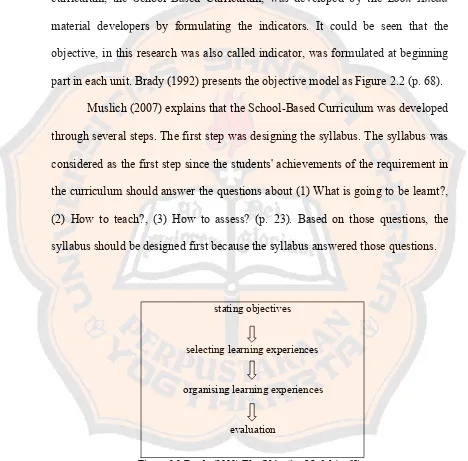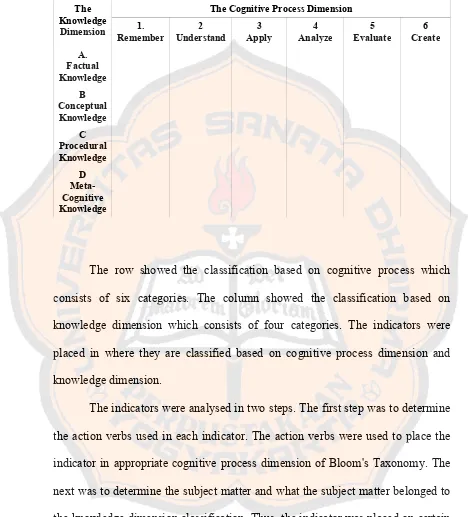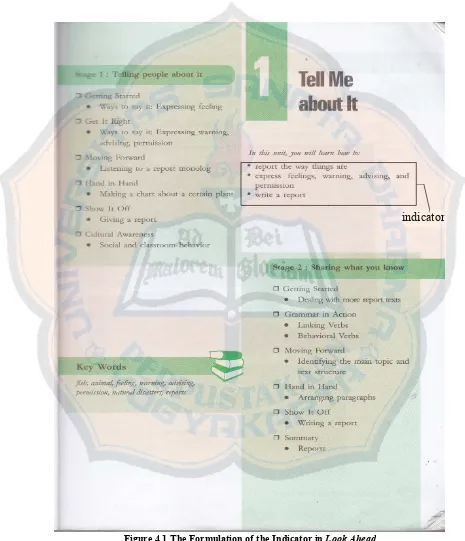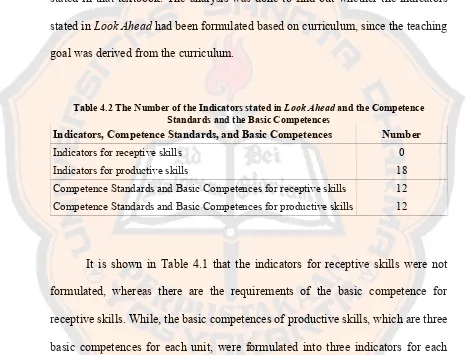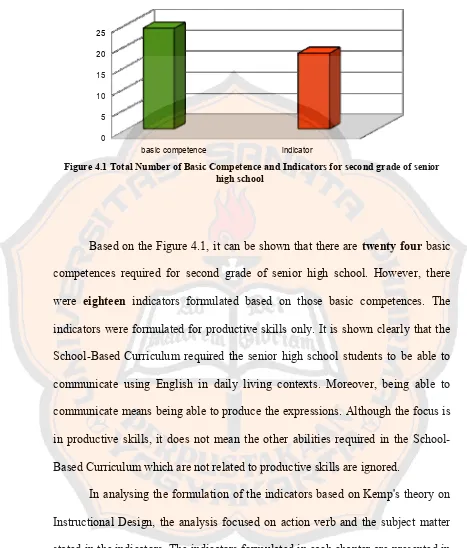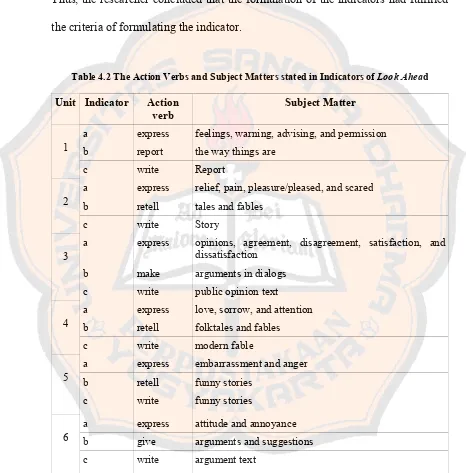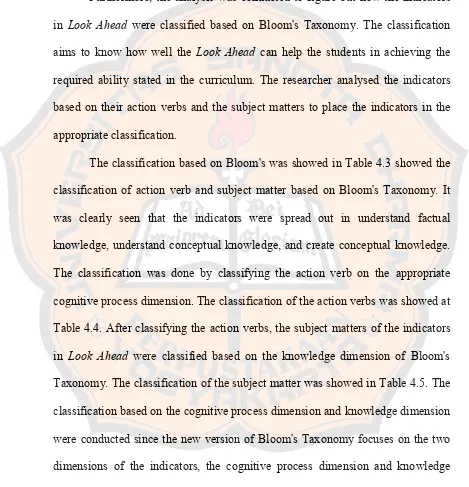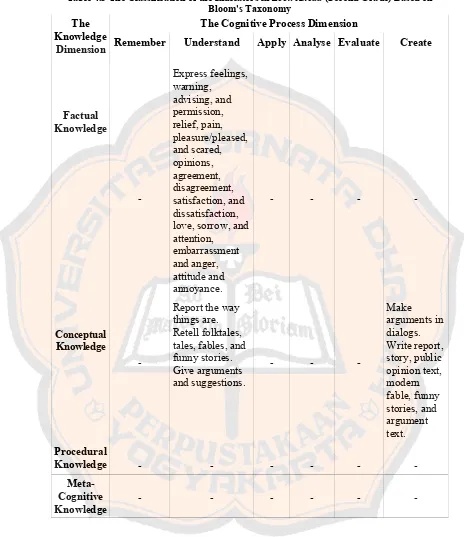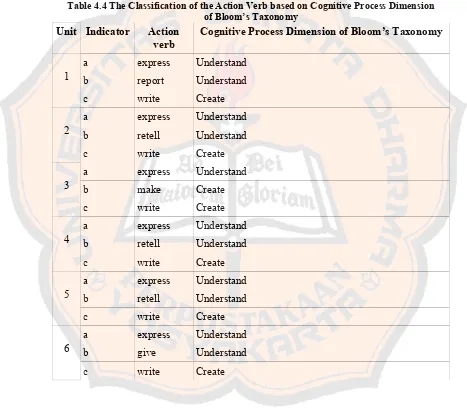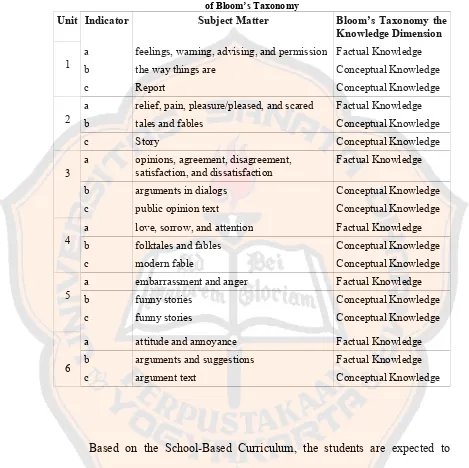ANALYSIS OF THE LEARNING INDICATORS IN
LOOK
AHEAD
(SECOND GRADE) BASED ON THE SCHOOL-BASED
CURRICULUM AND BLOOM'S TAXONOMY
ASARJANA PENDIDIKANTHESIS
Presented as Partial Fulfillment of the Requirements to Obtain theSarjana PendidikanDegree
in English Language Education
By
Gabriella Novianty Soedjarwo
Student Number: 071214045
ENGLISH LANGUAGE EDUCATION STUDY PROGRAM DEPARTMENT OF LANGUAGE AND ARTS EDUCATION FACULTY OF TEACHERS TRAINING AND EDUCATION
i
ANALYSIS OF THE LEARNING INDICATORS IN
LOOK
AHEAD
(SECOND GRADE) BASED ON THE SCHOOL-BASED
CURRICULUM AND BLOOM'S TAXONOMY
ASARJANA PENDIDIKANTHESIS
Presented as Partial Fulfillment of the Requirements to Obtain theSarjana PendidikanDegree
in English Language Education
By
Gabriella Novianty Soedjarwo
Student Number: 071214045
ENGLISH LANGUAGE EDUCATION STUDY PROGRAM DEPARTMENT OF LANGUAGE AND ARTS EDUCATION FACULTY OF TEACHERS TRAINING AND EDUCATION
iv
I go with what I believe in. I believe in God, I trust Him, and I trust myself.
-Anonymous
-Discipline is the bridge between goals and accomplishment.
-Jim Rohn
-Self-motivation is the key to all successes.
-Gaby-vii ABSTRACT
Soedjarwo, Gabriella Novianty. 2012. Analysis of the Learning Indicators in Look Ahead (Second Grade) Based on the School-Based Curriculum and Bloom's Taxonomy. Yogyakarta: English Language Education Study Program, Sanata Dharma University.
Education system in Indonesia always deals with curriculum as the goal in teaching. In the field, the curriculum are formulated in the form of indicators to see the students' achievements precisely. This research aims to analyse the indicators taken from Look Ahead (Second Grade) based on School-Based Curriculum and Bloom's Taxonomy since this textbook is used by most high schools in Yogyakarta. This research was essential to be done since the teaching material used in the classroom should be able to facilitate the students in achieving the required behaviour. Furthermore, the formulation of the indicators can be used as the aspect to know whether the the textbook can facilitate the students in achieving the requirement. There were two presented research questions: (1) How are the indicators in Look Ahead (Second Grade) formulated based on the School-Based Curriculum? and (2) How are the indicators in Look Ahead(Second Grade) classified based on Bloom's Taxonomy?
The theories used in this research were the learning cycle method, the School-Based Curriculum, the curriculum development, Kemp's theory on defining the indicators, and Bloom's Taxonomy. Those theories were used to answer the presented research questions. The Basic Competences used in this research was taken from the School-Based Curriculum. The researcher used the revised version of Bloom's Taxonomy to analyse the indicators. Kemp's theory was used to analyse whether the statement of the indicators had fulfilled the criteria.
The method used in this research was document analysis. This method was considered as the most appropriate method since the data were taken from documents, in this research was textbook and the School-Based Curriculum. The data were analysed using the Basic Competences on the School-Based Curriculum and Kemp's theory about the criteria of well-formulated indicators. After that, the indicators were analysed using Bloom's Taxonomy to find out their classifications.
viii ABSTRAK
Soedjarwo, Gabriella Novianty. 2012. Analysis of the Learning Indicators in Look Ahead (Second Grade) Based on the School-Based Curriculum and Bloom's Taxonomy. Yogyakarta: Program Studi Pendidikan Bahasa Inggris, Jurusan Pendidikan Bahasa dan Seni, Fakultas Keguruan dan Ilmu Pendidikan, Universitas Sanata Dharma.
Sistem pendidikan di Indonesia selalu berdasarkan pada kurikulum sebagai tujuan pembelajaran di sekolah. Pada prakteknya, kurikulum dijabarkan dalam indikator untuk melihat pencapaian para murid dengan lebih akurat. Penelitian ini bertujuan untuk menganalisis indikator-indikator yang terdapat pada Look Ahead 2 berdasarkan KTSP (Kurikulum Tingkat Satuan Pendidikan) dan Taksonomi Bloom. Buku cetak tersebut dijadikan sebagai subjek penelitian karena dipakai oleh sebagian besar sekolah di Yogyakarta. Penelitian ini dilakukan karena buku cetak diharapkan mampu memfasilitasi para murid dalam mencapai kemampuan di kurikulum. Penelitian ini merumuskan masalah dalam dua pertanyaan: (1) Bagaimana indikator-indikator yang terdapat di Look Ahead 2 diformulasikan berdasarkan KTSP? dan (2) Bagaimana indikator-indikator yang terdapat di Look Ahead2 diklasifikasikan berdasarkan Taksonomi Bloom?
Teori-teori yang digunakan adalah teori learning cycle, KTSP, teori pengembangan kurikulum, teori Kemp, dan Taksonomi Bloom. Teori-teori tersebut digunakan untuk menjawab pertanyaan yang telah dirumuskan. Standar Kompetensi dan Kompetensi Dasar yang digunakan diambil dari KTSP. Teori Kemp digunakan untuk mengetahui perumusan indikator yang baik. Sedangkan Taksonomi Bloom digunakan untuk mengklasifikasikan indikator-indikator tersebut.
Metodologi yang diterapkan pada penelitian ini adalah document analysis. Metode ini adalah metode yang paling sesuai karena data yang diambil berasal dari dokumen-dokumen, pada penelitian ini adalah buku cetak dan Kurikulum Tingkat Satuan Pendidikan. Data dianalisis menggunakan Kurikulum Tingkat Satuan Pendidikan dan teori Kemp tentang kriteria perumusan indikator yang benar. Setelah itu, indikator-indikator dianalisis menggunakan Taksonomi Bloom untuk mengetahui klasifikasi indikator-indikator tersebut.
Dari hasil analisis ditemukan bahwa indikator-indikator yang terdapat di Look Ahead telah memenuhi kriteria berdasarkan teori Kemp. Akan tetapi, indikator-indikator tersebut belum memenuhi persyaratan kompetensi yang dirumuskan pada kurikulum karena indikator yang terdapat pada Look Ahead hanya berfokus pada productive skills saja. Indikator-indikator tesebut berada padaunderstanding factual knowledge, understanding conceptual knowledge,dan creating conceptual knowledge berdasarkan Taksonomi Bloom. Penemuan lain dari penelitian ini adalah tidak adanya pembedaan micro dan macro skills dalam indikator-indikator tersebut, sedangkan pembedaan ini sangat beguna dalam penentuan bentuk penilaian pada murid.
ix
ACKNOWLEDGEMENTS
I would like to express my deepest and sincere thanks to all people who
support me in finishing my study. First of all, I would like to thank Made Frida
Yulia, S.Pd., M.Pd., my sponsor, for her guidance, help, and suggestions. I truly
give my deepest thank to my beloved dad, mom, and little sister for their never
ending prayers, love, and supports. My deepest gratitude is also addressed to Drs.
Y.B. Gunawan, M.A. for his encouragement to finish my study soon.
I also addressed my gratitude to my dear college friends: Reta, Agnes,
Redy, Calvin, Ajeng, Hedwig, Seto, Olive, Mei, and Indah P.Mat. for their support and also to Goreti, Mery, Esther, Lala, Adel, and Ami for the time we
share and laugh together. They really give me spirit in finishing my study.
I give my sincere thanks to Cana Community and Campus Ministry for all
the experiences and chances given to me. My special thanks is expressed to Sister
Margareth FCJ andMbakEndang as my proofreaders. I hope God bless them all.
x
TABLE OF CONTENTS
Page
TITLE PAGE …... i
APPROVAL PAGES …... ii
MOTTO PAGE …... iv
STATEMENT OF WORK'S ORIGINALITY …... v
PERNYATAAN PERSETUJUAN PUBLIKASI…... vi
ABSTRACT …... vii
ABSTRAK …... viii
ACKNOWLEDGEMENTS …... ix
TABLE OF CONTENTS …... x
LIST OF TABLES …... xii
LIST OF FIGURES …... xiii
LIST OF APPENDICES …... xiv
CHAPTER I. INTRODUTION A. Research Background ... 1
B. Problem Formulation …... 4
C. Problem Limitation …... 4
D. Research Objectives …... 5
E. Research Benefits …... 5
F. Definition of Terms …... 6
CHAPTER II. REVIEW OF RELATED LITERATURE A. Theoretical Description …... 8
1. Learning Cycle Method …... 8
2. Curriculum Development …... 10
3. School-Based Curriculum …... 12
3. Defining Indicators …... 13
4. Bloom's Taxonomy …... 14
xi CHAPTER III. METHODOLOGY
A. Research Method …... 23
B. Research Setting …... 24
C. Research Subject …... 24
D. Research Instruments and Data Gathering Techniques …... 25
E. Data Analysis Technique …... 26
F. Research Procedure …... 29
CHAPTER IV. RESEARCH FINDINGS AND DISSUSSION A. The Formulation of Indicators inLook Ahead (Second Grade) Based on School-Based Curriculum …... 32
B. The Classification of the Indicators inLook Ahead Based on Bloom's Taxonomy ... 41
C. Other Findings …... 49
CHAPTER V. CONCLUSIONS AND RECOMMENDATIONS A. Conclusions …... 51
xii
LIST OF TABLES
3.1 Taxonomy in Use …... 28
4.1. The Number of Indicators Stated inLook Aheadand
Competence Standards and Basic Competences …... 34
4.2. The Action Verb and Subject Matter Stated in Indicators ofLook Ahead 41 4.3 The Classification of the Indicators Based on Bloom's Taxonomy …. 46
4.4 The Classification of the Action Verb Based on Cognitive Process
Dimension of Bloom’s Taxonomy …... 45
4.5 The Classification of the Subjects Matter Based on the Knowledge
xiii
LIST OF FIGURES
2.1. The Objective Model of Curriculum Development …... 10
4.1 The Formulation of the Indicator inLook Ahead…... 33 4.2 Total Number of Basic Competence and Indicators for second grade
xiv
LIST OF APPENDICES
1. Indicators Stated inLook Ahead ... 57 2. Competence Standard and Basic Competence for Second Grade
1
CHAPTER I
INTRODUCTION
This chapter consists of the research background, problem formulation,
problem limitation, research objectives, research benefits, and definition of terms
of this research.
A. Research Background
Education system in Indonesia always deals with curriculum. The
government regulates the curriculum to set the standard achievement of the
students in every school in Indonesia. In Indonesia, the curriculum changes every
five years. The change in curriculum is aimed to achieve better education.
Indonesia has implemented Kurikulum Tingkat Satuan Pendidikan(KTSP) or the
School-Based Curriculum since 2006/2007 academic year.
The School-Based Curriculum was regulated to set the Competence
Standards and the Basic Competences. These Competence Standard and Basic
Competence are the basic in defining the indicator. Based on Peraturan
Pemerintah no.22 Tahun 2006, the senior high school students must achieve the
informational language skill of English. Wells (1987) explains that in the
informational stage, the students are supposed to be able to access the knowledge
by using the target language.
To achieve that level, the learning indicator should be well formulated to
make the teacher see the students' development clearly. The classification used in
Cruikshank, Mayer, Pintrich, Raths, and Wittrock explanation (2001), Bloom's
Taxonomy is designed to classify the educational indicator. The indicator is used
to describe students' behaviour after certain process in education. Classification is
given to help the teacher to organize the educational indicator (pp. 4-5). Bloom's
Taxonomy here is used to look at the increase in students' ability precisely.
Bloom (1972) classifies the education taxonomy into six stages;
knowledge, comprehension, application, analysis, synthesis, and evaluation (p.
18). Bloom's Taxonomy was arranged from simple to complex educational
behaviour. However, Anderson, former student of Bloom, led the change on
Bloom's Taxonomy in 2000. Schultz and Overbaugh (2010) explain the taxonomy
was arranged as remembering, understanding, applying, analyzing, evaluating,
and creating. The significant change is on the two highest stage, creating
considers as the highest level, not evaluating.
Another change made by Anderson is the use of noun instead of verb. As
the original taxonomy, which classified the indicator in six stages by using noun
to classify the indicator, the revised version of Bloom's Taxonomy uses noun
instead of verb. This change was made because the revised version of Bloom's
Taxonomy focuses on two-dimensional taxonomy in defining the indicator. The
revised version of this taxonomy focuses on the knowledge and how to acquired
the knowledge, thus the change from noun to verb was made.
According to Kemp (1977) theory, indicator must be stated using terms
that can promote learning (p. 23). Moreover, Lindvall (1964) explains that by
influence on what they learn in school (p. 2). thus, in formulating the indicators,
the selection of appropriate action verb is essential to be considered. Referring to
the appropriate actions verbs to be used in defining the indicator is important. It is
because the indicator aims to measure students' achievement and action verbs are
used to measure this achievement of the educational behaviour clearly. Thus, to be
able to see the students' achievement, action verb is the best choice in defining the
indicator. Related to action verb, each stage in Bloom's Taxonomy refers to
certain action verbs used in defining the indicator.
The analysis on the indicators should be formulated based on Basic
Competences stated in the School-Based Curriculum as supported by the Brady's
model in developing the curriculum which was the objective model. These
Competence Standards and Basic Competences are implemented in the form of
indicators stated in the textbook by material developers. As it is in Look Ahead
(Second Grade), the indicators are stated in the beginning of each chapter.
This research analyses how the indicators in Look Ahead (Second Grade)
an English Textbook are formulated based on the the School-Based Curriculum
and how are the formulation of those indicators based on Bloom's Taxonomy.
After conducting small preliminary research, the researcher gained the answer that
Look Ahead is the mostly used textbook for English lesson especially in
Yogyakarta. It is essential to conduct this research since Look Aheadtextbook is
the most frequently used textbook for senior high school students. Furthermore,
the material takes an influence in the students' success in gaining the expected
B. Problem Formulation
From the background above, the researcher formulated the following
questions:
1. How are the indicators inLook Ahead(Second Grade) formulated based on the
School-Based Curriculum?
2. How are the indicators in Look Ahead (Second Grade) classified based on
Bloom's Taxonomy?
C. Problem Limitation
This research will focus on analysingLook Ahead(Second Grade) written
by Th. M. Sudarwati and Eudia Grace. This textbook was published by Erlangga
in 2007. The parts to be analysed are the indicators stated in the textbook and how
the indicators are classified based on Bloom's Taxonomy.
Look Ahead formulated a indicator as In this unit, you will learn how to
express feelings, warning, advising, and permission. Kemp (1977) explains that
the indicators show the learning outcome (p. 23), thus the part of the indicators
stated in Look Ahead which was regarded as the indicator was express feelings,
warning, advising, and permission. The analysis was conducted by classifying
the action verbs and the subject matter used based on School-Based Curriculum,
Kemp's theory and Bloom's Taxonomy.
Since this research focuses on textbook for second grade of senior high
school, the competence standard and the basic competence are used as the
aims to see how the indicators in Look Ahead (Second Grade) are formulated
based on the competence standard and the basic competence. This research refers
to the revised version of Bloom's Taxonomy for classifying the indicators. The
use of appropriate action verb in formulating indicators is considered important in
this research since action verbs describe the expected cognitive process.
D. Research Objectives
Referring to the problem formulation above, the objectives of this research
are:
1. to find out the formulation of the indicators in Look Ahead (Second Grade)
based on Competence Standards and Basic Competences in the School-Based
Curriculum.
2. to find out the classification of indicators in Look Ahead based on Bloom's
Taxonomy.
E. Research Benefits
This research will be beneficial for the parties which work in English
teaching area such as material developers and the teachers in defining proper
indicators. This research analyses how the material developers formulated the
indicators as stated in the textbook. The researcher expects that this research will
become their additional knowledge on how to formulate appropriate indicators.
This research will also be beneficial for English teachers at school. The
will consider more carefully in taking textbook as the source of teaching in
school. This research will give the information how the indicators in Look Ahead
are formulated and hopefully this information makes the teacher use the textbook
wiser.
F. Definition of Terms
Some terms below need to be defined in order to avoid misunderstanding.
These definitions are:
1. Learning Indicator
Indicator is formulated based on competence standard and basic
competence stated in the curriculum. This research considers that objective is the
same as indicator. Kemp (1977) defines indicator as outcome of the instruction (p.
23). Thus, indicators are the educational behaviours that are expected to be
achieved and these indicators are derived from the basic competence stated in the
curriculum. The basic competence should be derived in the form of indicators to
measure the students' achievement after doing educational process. Moreover,
Kemp (1977) explains that indicator should be stated by using action verb to
promote learning (p. 23). In this research, the indicators are taken from the Look
Ahead (Second Grade) English textbook. The example of the part of the
formulated indicators stated in Look Ahead which is regarded as the learning
indicator isexpress feelings, warning, advising, and permission.
2. Bloom's Taxonomy
distinctions among students' behaviour (p. 13). Anderson et al. (2001) explain that
Bloom's Taxonomy is a kind of framework to classify the educational indicators
(p. 4). Bloom's Taxonomy explains that there is an improvement in the students'
achievement after attending certain educational processes.
Based on Anderson et al. (2001) explanation, the revised version of
Bloom's Taxonomy sees the intended cognitive process and the knowledge to be
acquired by the students. The new version of this taxonomy classifies the
cognitive process dimension into six stages namely Remembering, Understanding,
Applying, Analyzing, Evaluating, and Creating (p. 5).
The revised version of Bloom's Taxonomy also distinguishes the
knowledge dimension into four level. The major types of knowledge dimension
stated by Anderson et al. (2001) are factual knowledge, conceptual knowledge,
procedural knowledge, and metacognitive knowledge (p. 46). The researcher uses
the revised version of Bloom's Taxonomy. This revised version is used as the
8
CHAPTER II
REVIEW OF RELATED LITERATURE
This chapter consists of theoretical description and theoretical framework.
Theoretical description describes all the theories used in this research. Whereas,
theoretical framework explains how the theories are related to each other.
A. Theoretical Description
In this section, the researcher elaborates the theories used in this research.
The theories include Learning Cycle Method, Curriculum Development,
School-Based Curriculum, Defining Indicators, and Bloom's Taxonomy.
1. Learning Cycle Method
The learning cycle method was proposed by Callaghan and Rothery in
1988. This method consists of four stages. The first stage is building knowledge
of the field. The second one is modeling or deconstruction. The next is joint
construction. The last stage is independent construction. The learning cycle
method involves the four skills in learning language namely listening, speaking,
reading, and writing. However, this method focuses on the productive skills only,
speaking and writing.
In building knowledge of the field stage, the students are given the new
concept in their new language, in this case English. Beside building the new
concept, the students share their prior knowledge about the topic being discussed.
brainstorming, vocabulary development, and hands on experiences.
After building the new concept and sharing the prior knowledge, the
students move on to modeling stage. In this stage they are familiarised with the
text genre, so they will be able to “read” the text and deconstruct that text. The
activities that are useful in this stage such as sorting text, sequencing stages,
highlighting parts of the text, and vocabulary building task.
The next stage is joint construction stage. In this stage, the students have
the experience in the text. The students are also provided with strategies to guide
them in building the knowledge in the field. The technique that may be useful are
writing key structural or grammatical words on sticky note, demonstrating on the
board how to make a sentence using those words, and asking the students to
arrange their sticky note in a sentence.
The students are expected to be able to apply what they have learnt before
in independent construction stage. In this stage, the students have been ready to
plan and complete their own research and make their own text. The roles of the
teacher in this stage are monitor and provide support and guide for the students
when they are needed.
2. Curriculum Development
The curriculum can be developed through two models. Brady (1992) states
that there were two models of curriculum developments that were used mostly,
namely objective model and interaction model (p. 68). It was called objective
model because the curriculum was developed by formulating the educational
curriculum was seen as dynamic process which could begin with any curriculum
elements in any sequences (p. 74).
The model to be used in this research was objective model since the
curriculum, the School-Based Curriculum, was developed by the Look Ahead
material developers by formulating the indicators. It could be seen that the
objective, in this research was also called indicator, was formulated at beginning
part in each unit. Brady (1992) presents the objective model as Figure 2.2 (p. 68).
Muslich (2007) explains that the School-Based Curriculum was developed
through several steps. The first step was designing the syllabus. The syllabus was
considered as the first step since the students' achievements of the requirement in
the curriculum should answer the questions about (1) What is going to be learnt?,
(2) How to teach?, (3) How to assess? (p. 23). Based on those questions, the
syllabus should be designed first because the syllabus answered those questions.
Figure 2.2 Brady (1992) The Objective Model (p. 68)
After designing the syllabus, the next steps were designing map of stating objectives
selecting learning experiences
organising learning experiences
standard competences, time allocation analysis, year and semester programmes,
and lesson plan (pp. 41-45). In designing the lesson plan, there were eleven steps
to be followed. Those steps were (p. 46):
1. taking one teaching unit to be implemented
2. formulating competence standard and basic competence of that teaching unit
3. stating the indicators to achieve those competence standard and basic
competence
4.stating the time location need to achieve those indicators
5. formulating the teaching goals
6. choosing the teaching material to be given in class to achieve the teaching goals
7. choosing the teaching method that could supported the material and teaching
goals
8. arranging pre activities, whilst activities, and post activities for each teaching
goals
9. dividing the teaching-learning process into several meetings if one basic
competence could not be achieved in one meeting
10. mentioning the teaching material to be used in each meeting
11. stating the assessment technique, form and the example of the assessment
instrument along with scoring, the exercise, and rubric
Based on the steps in designing the lesson plan above, it was clearly seen
that the indicators and the material used in the classroom should be based on basic
competences stated in the curriculum. It was because all the teaching-learning
curriculum. Thus, the indicators stated in the teaching material such as the
textbook, should also be formulated based on curriculum.
3. School-Based Curriculum
Based on Peraturan Pemerintah no.22 Tahun 2006, English lesson in school is aimed to develop the students' ability in communicating.
Communicating here means the students are able to communicate in oral and
written ways. Thus, English lesson at schools should help the students to acquire
English proficiency in informational level, in which the students are expected to
be able to use English to communicate and gain information.
Wells (1987) as cited in School-Based Curriculum, literary ability is
divided into three skills, performative, functional, informational, and epistemic. As it was explained above, for senior high school students, they are expected to
reach informational level. The purpose of reaching this level is as their preparation
in entering university. This educational behaviour is stated in the Competence
Standard and Basic Competence.
4. Defining Indicators
In education, defining indicators is important. Indicators are formulated to
give the direction and goal in teaching learning activities. From the teacher's point
of view, indicators are used to monitor the ways in which students are expected to
be changed by the education process. Moreover, indicators are important since
explained teaching as an intentional act means the teaching activities must have a
purpose and the primary purpose in teaching to facilitate the students. While
teaching as reasoned act means what teacher gives to the students should be
worthwhile for the students (p. 3).
Based on Kemp's explanation (1977), the indicators should be defined
since a learning process deals with the outcome of the instruction (p. 23).
Moreover, Kemp explained that indicators must be stated in terms of activity
since learning needs active effort of the students (p. 23). In formulating indicators,
the teacher should ask himself “What does the student have to do in order to show
that he or she has learnt what you want the student to learn?” To answer the
question well, Kemp (1977) explained the teacher should write the objectives
consisting of at least two essential parts and two optional parts as (p.29):
1. Start with an action verb that describes a specific behaviour or activity by the
learner.
Example:write
2. Follow the action verb with content reference that describes the subject being
treated.
Example: writea report.
3. If the aforementioned essential parts of an objective lend themselves to some
quantification, add a performance standard that indicates the minimum
acceptable accomplishment in measurable terms. For a competency-based
program, including such performance standards is almost essential for
Example: write a reportone page long.
4. As necessary for students understanding and in order to set evaluation
requirements, add any criteria or conditions under which the learning must
take place.
Example: write a report one page longindividually.
5. Bloom's Taxonomy
Bloom's Taxonomy classifies objectives in learning. A statement of
objective contains a verb and a noun. The verb describes the intended cognitive
process while the noun describes the acquired knowledge for the students. Based
on the explanation before, the revised version of Bloom's Taxonomy pays
attention to two dimension in education, the cognitive process and the result or
knowledge (pp. 4-5).
The cognitive process dimension contains six categories namely
remember, understand, apply, analyze, evaluate, and create, as it is stated by
Aderson et al (2001). These categories are divided based on its complexity (p. 5).
It means understand is cognitively more complex than remember, analyse is
cognitively more complex than apply and so on.
The knowledge dimension contains four categories namely factual,
conceptual, procedural, and metacognitive, as it is explained by Anderson et al
(2001). The idea of knowledge dimension is the continuum in learning. Students
learn from concrete knowledge, factual knowledge, to more abstract knowledge,
conceptual knowledge is more abstract than factual knowledge, Metacognitive
knowledge is more abstract than procedural knowledge, and so on.
a. Knowledge Dimension
In Bloom's Taxonomy, knowledge dimension is divided into four
categories. They are Factual Knowledge, Conceptual Knowledge, Procedural
Knowledge, and Metacognitive Knowledge.
1) Factual Knowledge
Factual knowledge is related to knowledge of terminology and specific
detail. Anderson et al. (2001) define factual knowledge as knowledge of the basic
elements that experts use in communicating about their academic discipline,
understanding it, and organizing it. The students should master the factual
knowledge of certain subject first before they are able to deal with the subject and
solve the problem in it. Factual knowledge is considered as low level of
abstraction (p. 45).
2) Conceptual Knowledge
Conceptual knowledge builds the students' concept of a certain topic.
Anderson et al. (2001) define conceptual knowledge as knowledge about
categories and classifications and the relationship among them. Conceptual
knowledge means the students are able to interrelate and interconnect in
systematic manner and how the bits of knowledge are functioned together (pp.
3) Procedural Knowledge
It is clear that procedural knowledge is related to the procedure or step in
doing something. Anderson et al. (2001) state by knowing the procedural
knowledge of the subject, the students are expected to know how to do something
related to the matter. Procedural knowledge is mostly in the form of a series or
sequence of step that should be followed. It also includes knowledge of the
criteria in determining when to use various procedures. Procedural knowledge
differs from factual and conceptual knowledge. The procedural knowledge
focuses on how and the process rather than just what (pp. 52-53).
4) Metacognitive Knowledge
the last category in knowledge dimension is metacognitive knowledge.
This knowledge is considered as the ability to help the students able to promote
the better learning. Anderson et al. (2001) explain metacognitive knowledge is
knowledge about the subject matter in general and also the awareness of and
knowledge about the students' own cognition. Acquiring metacognitive
knowledge will make the students more aware of and responsible for their own
knowledge and thought (p. 55). Bransford, Brown, and Cocking (1999) as cited by
Anderson et al., state that by developing metacognitive knowledge, the students
will become more aware of their own thinking and also more knowledgeable
about cognition in general, and this awareness will build a better learning.
b. The Cognitive Process Dimension
In classroom activities, the cognitive process needs to be examined
means learning process should result learning outcome. Through cognitive
dimension process, the teacher can examine the learning process of the students
beyond remembering level. In Bloom's Taxonomy, the cognitive process
dimension is divided into nineteen specific cognitive processes that belong to six
categories of cognitive process; remember, understand, apply, analyse, evaluate,
and create.
1) Remember
Remember is considered as the lowest level of abstraction. Anderson et
al.(2001) state that to assess students in the simplest way, the students can be
given a recognition or recall task under conditions that are similar to those in
which they learn the material. Reaching remember level is important to gain
meaningful learning and problem solving since remember leads to more complex
tasks (p. 66). Kemp (1977) lists the common action verbs used in remember
category are arrange, define, duplicate, list, memorise, name, order, recognise,
label, relate, recall, repeat, and reproduce (p.31).
2) Understand
Being understand means the students are able to follow the learning
instruction. Anderson et al. (2001) state that understand is considered as the first
step to promote transfer in learning process. When the students can understand the
material, they can obtain meaning from instructional messages. The students are
considered understanding the material when they are able to build the connection
between the new knowledge to be gained and their prior knowledge. Related to
(p. 70). Kemp (1977) lists the common action verbs used in understand category
are classify, describe, discuss, explain, express, identify, indicate, locate,
recognise, report, restate, select, tell, and translate (p. 31).
3) Apply
The next category is apply. Applying has the meaning implementing the
appropriate steps. Anderson et al. (2001) explain that apply involves the ability in
implementing the procedures to perform exercises or solve problem. Apply is
related to procedural knowledge. For a familiar task, the students should know
what procedural knowledge to use. On the other hand, for an unfamiliar task the
students should know what procedural knowledge will be used. Contrast to
executing, implementing requires deep understanding about the problem and the
solution procedure as well. For implementing, understanding the conceptual
knowledge is a prerequisite to being able to apply procedural knowledge (p. 77).
Kemp (1977) lists the common action verbs used in apply category are apply,
choose, demonstrate, dramatise, employ, illustrate, interpret, operate, schedule,
sketch, solve, and use (p. 31).
4) Analyse
After being able to apply, the students are expected to be able to analyse.
Anderson et al. (2001) say that analysing means breaking down material into its
constituent parts and determining how the parts are related to one another and to
an overall structure. Analyse is closely related to other levels in cognitive process
such as differentiating, organizing, and attributing. In analysing level, students are
(differentiating), understand the ways in which the pieces of message are
organised (organising), and know the underlying purpose of the message
(attributing). Analysing is also considered as an extension of understanding or as
an introduction to evaluating or creating (p. 79). Kemp (1977) lists the common
action verbs used in analyse category are analyse, appraise, calculate, categorise,
criticise, differentiate, discriminate, distinguish, examine, experiment, question,
and test (p. 31).
5) Evaluate
In evaluating, the students are required to master the criteria in making
judgment. Anderson et al. (2001) explain evaluating means making judgments
based on criteria and standards. Evaluating includes the cognitive processes of
checking, judgment about internal consistency, and critiquing, judgments based
on external criteria. However, not all judgments are called evaluating. The
difference between evaluating and judging is the use of certain criteria in
evaluating (p. 83). Kemp (1977) lists the common action verbs used in evaluate
category are appraise, argue, assess, compare, defend, judge, select, support,
value, and evaluate (p. 31).
6) Create
Create is considered as the highest cognitive ability. Anderson et al.
(2001) explain that create involves the ability to put elements together to form a
coherent or functional as a whole. Create makes the students able to produce a
new product that has never or implicitly been presented before. Even create
result of free creative expression. However, in creating such a creative or different
product, certain demands of learning task or situations are required (pp. 84-85).
Create is closely related to creativity. However, the concept of creativity is
still unclear sometimes. Anderson et al. (2001) state in some ideas, creativity is
the production of unusual products, often as a product of special skill. Although
many indicators in create category focuses on originality, educators must state
clearly what it means by being original or unique. In other cases, creating can
involve the ability to synthesize all materials into a whole (p. 85).
Furthermore, create is also related to be able to produce the new product
and this new product is the original product from the students. Anderson et al.
(2001) also explains that unlike the other cognitive categories, create category
requires the students to be able to produce a new and original product. Unlike
create category, the other cognitive categories involve working with a part of
information from a whole which should be understood by the students. On the
other hand, in create category, the students should be able to make a new product
from many sources based on students' prior knowledge (p. 85). Kemp (1977) lists
the common action verbs used in create category are assemble, construct, create,
combine, design, develop, formulate, plan, set up, and write (p. 31).
B. Theoretical Framework
In this part, the researcher would like to synthesise the theories which are
related to data analysis. The learning cycle method proposed by Callaghan and
textbook.Look Aheadwas designed by following this learning cycle method. The theory of curriculum development was used to support the idea that the indicators
were important to be analysed since the curriculum can be developed through
formulating the indicators. In this research, the indicators in Look Ahead were formulated to help the students achieving the requirement in School-Based
Curriculum. This analysis was done as supported by the theories from Brady and
Muslich.
Brady (1992) presents the objective model in developing the curriculum.
This theory explained that the curriculum should be developed by formulating the
indicators as teaching goals and experiences. Musclich (2007) explains the steps
in developing the School-Based Curriculum. In the presented steps, it could be sen
that the formulation of the indicators should be based on curriculum. Furthermore,
Musclish also explains the material used in the classroom should be able to
facilitate the students in achieving the required behaviour.
School-Based Curriculum is the basic in analysing the indicators in Look Ahead, whether the indicators have represented the Basic Competence well. Besides analysing the indicators based on School-Based Curriculum, those
indicators were analysed related to the criteria of well-defined indicators. Related
to defining a well-defined indicator, the researcher takes the theory about learning
objectives explained by Kemp. The steps in formulating indicator stated by Kemp
(1977) are the criteria in which the indicators inLook Aheadwere analysed. There are four criteria however, the analysis focuses on two essential parts of indicator
Indicators in Look Ahead were also classified based on Bloom's Taxonomy. The indicators were placed in the appropriate category which includes
the knowledge dimension and the cognitive process dimension. In order to place
the indicators in the right category, the analysis paid attention to the use of the
action verb and also the subject matter stated in the indicators. The verb was used
to place the indicators in cognitive process dimension while the subject matter
was used to place the indicators in knowledge dimension. Classifying the
indicators aims to know the classification of the English proficiency required in
23
CHAPTER III METHODOLOGY
This chapter presents the research methodology used in this research. The
explanation about the methodology used includes method, research instruments,
research subject, and data gathering technique, data analysis technique, and
research procedure.
A. Research Method
The appropriate method used in a particular research is important to be
considered, because the method chosen will be the guide to accomplish the
research. There were two research questions presented in this research. They were
(1) How are the indicators inLook Ahead(Second Grade) formulated based on the
School-Based Curriculum? and (2) How are the indicators inLook Ahead(Second
Grade) classified based on Bloom's Taxonomy? To answer those two research
questions, document analysis was chosen as the method, as supported by Ary,
Jacobs & Sorensen (2010) “content or document analysis is a research method
applied to written or visual materials for the purpose of identifying specified
characteristics of the material” (p. 457).
To answer the first research question, which aims to look at the
formulation of the indicators in Look Ahead based on the School-Based
Curriculum, the researcher chose document analysis since the data was taken from
theLook Ahead(Second Grade) textbook published in 2007 and the School-Based
indicators based on Bloom's Taxonomy, was taken fromLook Aheadas well.
Ary, Jacobs & Sorensen (2010) explained that document analysis focuses
on analysing and interpreting recorded material (p. 29). The recorded materials
that can be analysed and interpreted here are public records, textbook, letters
films, tapes, diaries, and other documents. Furthermore, Best (1959) explains that
“Document analysis should serve a useful purpose in research, adding important
knowledge to a field research, or yielding information that is helpful in evaluating
and improving social or education practices……” (p. 134). Based on the
explanation above, document analysis is the most appropriate method for this
research.
B. Research Setting
This research which is about analysing the indicators stated inLook Ahead
based on Bloom's Taxonomy was conducted on February 2011 until February
2012. The preliminary research was conducted at English Education Study
Program Sanata Dharma University in February 2011.
C. Research Subject
The subject of this research is the indicators which were formulated in
Look Ahead English textbook published by Erlangga in 2007. Those indicators
were analysed how they were formulated based on the School-Based Curriculum
and the classification based on Bloom's Taxonomy.
competence standard and basic competence stated in the School-Based
Curriculum. Furthermore, this research also analysed how the indicators were
classified based on Bloom's Taxonomy.
D. Research Instruments and Data Gathering Technique
This section elaborates the instruments and the data gathering techniques
of this research. Research instruments part elaborates the types of instrument used
in order to obtain dependable data to answer the research questions. While the
data gathering techniques part elaborates the techniques in obtaining the answer of
each research question.
1. Human Instrument
Ary, Jacobs & Razavieh (2002) explain one of the major characteristics of
qualitative research is human instrument. It means human was the main
instrument in gathering and analysing the data (p. 420). Based on the explanation,
the researcher was the research instrument in this research. To obtain the answer
of both research questions, the researcher gathered the data fromLook Aheadand
the School-Based Curriculum. The researcher wrote down all the indicators found
in Look Ahead. She also gathered the Basic Competences for second grade of
senior high school from the curriculum. For her roles in this research, the
researcher was the research instrument.
Furthermore, Poggenpoel and Myburgh (2003) explain that researcher as
the research instruments means the researcher was the key for obtain the data. In
researcher as the instruments also had a role to share the research findings to the
readers.
2. Document
Since this research belongs to document analysis, the document itself is
the research instrument. Best (1959) explains the data that is commonly used in
document analysis could be taken from textbook and any recorded theory (p. 133).
In this research the document to be used was a textbook. TheLook Ahead(Second
Grade) English textbook published at 2007 was chosen to be analysed since many
schools use this textbook as it is the mostly used textbook. Look Ahead(Second
Edition) English textbook as the research instruments since the data in this
research was taken from that textbook. The part of this textbook which became
the data for this research was the indicators.
Another document to be used was the School-Based Curriculum. The
School-Based Curriculum was used to gather the data about the Basic
Competences required for second grade of senior high school students. The
School-Based Curriculum as the research instrument since the basic competences
used in this research was taken from the School-Based Curriculum.
E. Data Analysis Techniques
The indicators stated in the textbook were analysed based on the
School-Based Curriculum. The analysis of the first research question aimed to see
whether the curriculum has been well-presented in the indicators. It was clearly
based on the School-Based Curriculum by looking at how many Basic
Competences required in each unit of the textbook and the indicators formulated.
Well-formulated indicators could also be seen on the subject matter stated in the
indicators and the required competence stated in the School-Based Curriculum.
Furthermore, the analysis was conducted based on the criteria of a
well-formulated indicator. The criteria were taken from Kemp's instructional design
theory (1977) on how to formulate the indicators well. Kemp explains how to
formulate indicator step by step. The indicators in Look Ahead were analysed
based on those steps to know how well they were formulated. To obtain the
answer of second research question, the researcher listed all the action verbs and
subject matters found in the indicators.
The second research question was answered by analyzing the classification
of the indicators based on Bloom's Taxonomy. The classification of these
indicators aimed to know how far the Look Ahead English textbook could help
students to achieve the expected ability based on School-Based Curriculum. The
analysis was done by focusing on the use of the action verb and the subject matter
stated in the indicators.
The analysis on the classification of the indicators was presented in the
form of taxonomy table. As explained before that the revised version of Bloom's
Taxonomy focused on two-dimensional taxonomy. Thus, the table presented the
place of the indicator in two-dimensional taxonomy. Since it focused on two
dimensions of the indicators, the action verbs and the subject matter took a focus
Table 3.1 Taxonomy in Use
The row showed the classification based on cognitive process which
consists of six categories. The column showed the classification based on
knowledge dimension which consists of four categories. The indicators were
placed in where they are classified based on cognitive process dimension and
knowledge dimension.
The indicators were analysed in two steps. The first step was to determine
the action verbs used in each indicator. The action verbs were used to place the
indicator in appropriate cognitive process dimension of Bloom's Taxonomy. The
next was to determine the subject matter and what the subject matter belonged to
the knowledge dimension classification. Thus, the indicator was placed on certain
classification that was appropriate for both cognitive process dimension and
F. Research Procedure
This research was conducted through several steps. Those steps
significantly show how this research was conducted.
1. Preliminary Research
Preliminary research aims to know the textbook used mostly by high
schools in Yogyakarta. Preliminary research was conducted by the researcher to
the students who did their PPL (Program Pengalaman Lapangan), students who
taught in school, and one of the biggest book stores in Yogyakarta. This
preliminary research was essential to be conducted since the document analysis
should significantly provide new knowledge to the field. Thus, this research took
the mostly used textbook in schools to gain more knowledge in the field of
education.
2. Gathering the Data
The data for this research was taken from document. The document used
was Look Ahead English textbook for second grade of senior high school
published at 2007. This research only focused on the indicators stated in the
textbook. Since this textbook was for second grade of senior high school, the
School-Based Curriculum to be used are the Competence Standard and the Basic
Competence for second grade of senior high school.
3. Gathering the Related Theories
Since this research belongs to document analysis, gathering the related
theories to analyse the data was important. The theories used in this research were
through indicators. The School-Based Curriculum was employed in this research
since the indicators were formulated based on the curriculum. Another theory
used in this research was Kemp's instructional design theory on how to formulate
the indicators. To classify the indicators, the researcher used the Bloom's
Taxonomy theory.
4. Analysing the Data
The data gathered was analyzed based the School-Based Curriculum and
Kemp's theory. The indicators were analysed on how well they represent the Basic
Competence stated in the School-Based Curriculum, whether all the Basic
Competences had been formulated in the indicators. The indicators were also
analysed based on the criteria in formulating a good indicator based on Kemp's
theory.
Then the researcher analysed the classification of the indicators based on
Bloom's Taxonomy. This analysis aims to know how this textbook could help the
students achieve the ability required by the Basic Competences in the curriculum.
The indicators were analysed using a taxonomy table.
The research findings from the analyses above, the analyses based on the
School-Based Curriculum and Bloom's Taxonomy, was related to the learning
cycle method. The relation the research finding based on the School-Based
Curriculum and Bloom's Taxonomy to the learning cycle method was that the
formulation of the indicators inLook Aheadwas influenced by the method used in
5. Drawing the Conclusion
The conclusion was drawn based on the result on how well the indicators
represent the Competence Standard and the Basic Competence and also how well
the formulation of those indicators was formulated based on the criteria in
formulating indicator. The conclusion was also the result of the indicators
classification based on Bloom's Taxonomy.
6. Writing Up the Research Report
The research that had been done was written in the form of the research
32 CHAPTER IV
RESEARCH FINDINGS AND DISCUSSION
This chapter is presented in two parts. The first is the objectives found in the Look Ahead (Second Grade). The second is the classification of those
objectives based on Bloom's Taxonomy and also the analysis on the use of action verb and its relation to Bloom's Taxonomy.
A. The Formulation of the Learning Indicators in Look Ahead (Second
Grade) based on the School-Based Curriculum
This part presents the research finding of the indicators found in Look Ahead and also the discussion about the analysis of those indicators based on
School-Based Curriculum and also Kemp's theory on the criteria of well-formulated indicator. The discussion is divided based on the unit in Look Ahead.
There are six units in this textbook. The researcher discussed the indicators found in each unit and their formulation based on the School-Based Curriculum and Kemp's theory. Furthermore, the analysis took a look at the how well each skill required in School-Based Curriculum was formulated in the form of indicator.
part being analysed in this research was the part in rectangle which stated the leaning outcome.
Figure 4.1 The Formulation of the Indicator inLook Ahead
The indicators stated in Look Ahead were important to be analysed since
the material used in the classroom should be able to help the students to achieve the teaching goal, as it was required in sixth step in designing the lesson plan. To find out that the teaching material, in this research was Look Ahead, could
facilitate the students to achieve the teaching goal, we could analyse the indicators stated in that textbook. The analysis was done to find out whether the indicators stated inLook Aheadhad been formulated based on curriculum, since the teaching
goal was derived from the curriculum.
Table 4.2 The Number of the Indicators stated inLook Aheadand the Competence Standards and the Basic Competences
Indicators, Competence Standards, and Basic Competences Number
Indicators for receptive skills 0 Indicators for productive skills 18 Competence Standards and Basic Competences for receptive skills 12 Competence Standards and Basic Competences for productive skills 12
It is shown in Table 4.1 that the indicators for receptive skills were not formulated, whereas there are the requirements of the basic competence for receptive skills. While, the basic competences of productive skills, which are three basic competences for each unit, were formulated into three indicators for each unit. The explanation about the formulation of the indicators for each unit is presented in the following paragraphs.
1. The Discussion of the Indicators in Unit 1
expressions of advising and warning, which involve listening and speaking skills. There is one indicator formulated based on those basic competences, which is (1.a) express feelings, warning, advising, and permission. This indicator was formulated for speaking skill and there was no indicator formulated for listening skill. Moreover, this indicator shows there is the expression of permission which does not belong to the basic competence.
The second part in this unit is report. There was one indicator formulated for writing skill which is (1.b) report the way things are. While, the indicator for writing skill is (1.c) write a report.
2. The Discussion of the Indicators in Unit 2
The second unit entitled Telling Stories (I) contains two topics. The first one is the expressions of feelings of relief, pain, and pleasure. The expressions of relief, pain, and pleasure involve two skills, listening and speaking. (2.a) express relief, pain, pleasure/pleased, and scared is the indicator formulated for speaking skill. There was no indicator formulated for listening skill. Like the previous unit, there is one expression, the expression of scared, which is not required in basic competence.
3. The Discussion of the Indicators in Unit 3
Unit 3 Figuring Out Conclusion contains the topics of the expressions of giving opinion, asking for opinion, showing satisfying, and showing unsatisfying and analytical exposition. The expressions of giving opinion, asking for opinion, showing satisfying and showing unsatisfying topic involves the listening and speaking skills. There was one indicator formulated based on this topic which is (3.a) express opinions, agreement, disagreement, satisfaction, and dissatisfaction. There was no indicator formulated for listening skill. The indicator above aims for speaking skill because the action verbexpressrelates to the ability of the students to produce the utterance, not to accept the utterance. This indicator does not contain the topic which is not required in Basic Competence.
The topic about analytical exposition in Unit 3 involves all abilities in learning language. There are two indicators formulated for analytical exposition. The first is (3.b) make arguments in dialogs. This indicator is formulated for speaking skill. The second indicator is (3.c) write a public opinion text. This indicator aims to define the writing skill. Based on the explanation above, this unit, like the previous units, there were no indicators formulated for receptive skills.
4. The Discussion of the Indicators in Unit 4
attention. This indicator was formulated for speaking skill, while there was no indicator formulated for listening skill. Moreover, there is one expression that does not include in the Basic Competence which is the expression of attention.
For the second topic, there were two indicators formulated for four skills in learning language. The indicator for speaking skill is (4.b) retell folktales and fables and for writing skill is (4.c) write a modern fable. There is no indicator formulated for listening and reading skills of narrative.
5. The Discussion of the Indicators in Unit 5
The next unit contains two topics, expressions of embarrassment and of anger and spoof. For expressing embarrassment and anger, which involve listening and speaking skills, there was one indicator formulated. (5.a) express embarrassment and anger is the indicator formulated for speaking skill, whereas there is no indicator formulated for listening skill.
For spoof topic, there are two indicators formulated. Both of them are for receptive skills. (5.b) retell funny stories is the indicator for speaking skill, while (5.c) write a funny story was the indicator formulated for writing skill. There is no indicator formulated for listening and reading skills.
6. The Discussion of the Indicators in Unit 6
For the hortatory exposition topic, there are two indicators formulated. The first is (6.b) give arguments and suggestions and the second is (6.c) write an argument text. The first indicator was formulated for speaking and the second for writing. Like the previous units, there was no indicator formulated for the listening and the reading skills.
In a brief, it can be concluded that the basic competences for speaking the utterances, the indicators use action verbs express. While for speaking the text genres, the indicators were formulated using action verbs report and retell. Action verb write was used to formulate all indicators for writing skills. As it seen in Table 4.1 the indicators stated in Look Ahead are only for productive
skills, the action verbs used were also for productive skills. The Basic Competences for the expressions for daily living context dialogue which cover listening and speaking skills were only formulated for speaking skill. While the Basic-Competences for text genre which cover all skills in learning the language were only formulated for speaking and writing skills.
Since the indicators were only formulated for productive skills, it means all basic competences for receptive skills were not formulated in the indicators. Thus, related to the total number, the number of the indicators stated in Look Aheadis less than the number of basic competences required in the School-Based
Curriculum. Based on the total number of required basic competences and the formulated indicators, it was concluded that the indicators inLook Ahead are not
well represented the curriculum yet. Thus, Look Ahead could not help the
Figure 4.1 Total Number of Basic Competence and Indicators for second grade of senior high school
Based on the Figure 4.1, it can be shown that there aretwenty four basic competences required for second grade of senior high school. However, there were eighteen indicators formulated based on those basic competences. The indicators were formulated for productive skills only. It is shown clearly that the School-Based Curriculum required the senior high school students to be able to communicate using English in daily living contexts. Moreover, being able to communicate means being able to produce the expressions. Although the focus is in productive skills, it does not mean the other abilities required in the School-Based Curriculum which are not related to productive skills are ignored.
In analysing the formulation of the indicators based on Kemp's theory on Instructional Design, the analysis focused on action verb and the subject matter stated in the indicators. The indicators formulated in each chapter are presented in Table 4.2.The researcher found out that all the indicators had fulfilled the required first and second criteria. The first criterion is the indicators must be started with an action verb. It is clear that the indicators stated inLook Aheadhave used action
basic competence indicator 0
verb to describe what the students should do in achieving the certain Basic Competence. The action verbs were used to show the intended action taken by the students. Based on the action verbs used in the indicators, it was shown that certain action verbs referring to certain skills in learning language. As the indicators above were formulated, the action verbs express, report, retell, and make referred to the speaking ability, which meant the students should be able to express certain expression well. While the action verb write referred to the writing ability which required the students to be able to write or compose a text in a certain genre.
Based on the analysis about the use of action verb, it can be shown that all the indicators stated inLook Aheadhad used action verbs. All the action verbs are
employed to define the productive skills. In this part, the formulation of the indicators had used action verb, as the essential part in defining the indicators.
The second criterion is the action verbs must be followed by the subject being treated. In the indicators above, the subject being treated is in the form of the topics or expressions. The topics mean the students are expected to be familiar with any kinds of text genres such as narrative and spoof. While expressions mean the students are expected to be able to use the expressions for certain situation such as advising and warning. In this element of formulating indicators, subject being treated is the subject matter to learn by the students in the classroom.
in the curriculum. Based on the analysis above, it is clear that all the subject matters required by the curriculum have been stated there. However, there are some other subject matters stated in indicators which do not belong to curriculum. Thus, the researcher concluded that the formulation of the indicators had fulfilled the criteria of formulating the indicator.
Table 4.2 The Action Verbs and Subject Matters stated in Indicators ofLook Ahead
Unit Indicator Action verb
Subject Matter
1
a express feelings, warning, advising, and permission b report the way things are
c write Report
2
a express relief, pain, pleasure/pleased, and scared b retell tales and fables
c write Story
3
a express opinions, agreement, disagreement, satisfaction, and dissatisfaction
b make arguments in dialogs c write public opinion text
4
a express love, sorrow, and attention b retell folktales and fables c write modern fable
5
a express embarrassment and anger b retell funny stories
c write funny stories
6
a express attitude and annoyance b give arguments and suggestions c write argument text
Ahead were analysed in two aspects. The first aspect was the formulation of the
indicators based on School-Based Curriculum. This analysis aimed to find out whether those indicators had represented the basic competences well. It was found out that the indicators stated inLook Ahead were formulated for productive skills
only.
The second aspect was the analysis of the indicators based on the criteria for well-formulated indicator. The researcher took Kemp's theory to analyse this aspect. The analysis showed that the formulation of the indicators in Look Ahead
had fulfilled the first and the second criteria, which were the essential parts in formulating the indicators. The indicators were formulated by writing the action verb and the subject matter. However, the indicators had not fulfilled the third and the fourth criteria.
B. The Classification of the Learning Indicators in Look Ahead Based on
Bloom's Taxonomy
After figuring out the formulation of the indicators in Look Ahead based
on the School-Based Curriculum and Kemp's theory, the next discussion is the analysis of those indicators based on Bloom's Taxonomy. This analysis aims to find out how Look Ahead could facilitate the students in achieving the
requirement in School-Based Curriculum.
the intended knowledge to be achieved by the students. Thus, in analysing the classification of the indicators based on Bloom's Taxonomy used the same element of the indicators, the action verb and the subject matter.
Furthermore, the analysis was conducted to figure out how the indicators in Look Ahead were classified based on Bloom's Taxonomy. The classification
aims to know how well the Look Ahead can help the students in achieving the
required ability stated in the curriculum. The researcher analysed the indicators based on their action verbs and the subject matters to place the indicators in the appropriate classification.
The classification based on Bloom's was showed in Table 4.3 showed the classification of action verb and subject matter based on Bloom's Taxonomy. It was clearly seen that the indicators were spread out in understand factual knowledge, understand conceptual knowledge, and create conceptual knowledge. The classification was done by classifying the action verb on the appropriate cognitive process dimension. The classification of the action verbs was showed at Table 4.4. After classifying the action verbs, the subject matters of the indicators in Look Ahead were classified based on the knowledge dimension of Bloom's
Table 4.3 The Classification of the Indicators inLook Ahead(Second Grade) Based on
Remember Understand Apply Analyse Evaluate Create
Factual
Based on the indicators stated previously, there some action verbs used in formulating the indicators stated inLook Ahead. Those action verbs were express,
